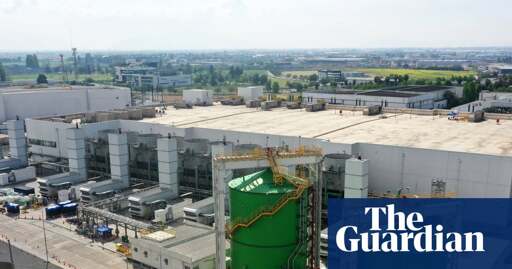Tech companies’ use of Pfas gas at facilities may mean datacenters’ climate impact is worse than previously thought
Two kinds of cooling systems are used to prevent the semiconductors and other electronic equipment stored in datacenters from overheating. Water cooling systems require huge volumes of water, and chemicals like nitrates, disinfectants, azoles and other compounds are potentially added and discharged in the environment.
Many centers are now switching to a “two phase” system that uses f-gas as a refrigerant coolant that is run through copper tubing. In this scenario, f-gas is not intentionally released during use, though there may be leaks, and it must be disposed of at the end of its life.
The datacenter industry has claimed that f-gas that escapes is not a threat because, once in the air, it turns into a compound called Tfa. Tfa is considered a Pfas in most of the world, but not the US. Recent research has found it is more toxic than previously thought, and may impact reproductive systems similar to other Pfas.
Researchers in recent years have been alarmed by the ever-growing level of Tfa in the air, water, human blood and elsewhere in the environment. Meanwhile, some f-gases are potent greenhouse gases that can remain in the atmosphere for thousands of years. But f-gasses are lucrative for industry: about 60% of all Pfas manufactured from 2019 to 2022 were f-gas



Water isn’t a renewable resource, especially not if the source of water is underground aquifers.
This is a long post, but these matters could be of grave importance.
The reason water isn’t always renewable is that statistically, most of the water on earth ends up in the oceans where it gets “trapped”. Sure, some of it evaporates and rains, but most of the rain is over the ocean. Some rain obviously makes it back to land, but most of it still stays in the ocean.
It’s extra bad if you pump water out of the ground from what are called aquifers. The water in the ground has taken thousands of years to build up, so pumping it out for dumb reasons is not a good idea. We could argue about growing food with ground water, but most people might consider squandering ground water where it is optional to do so, to be short sighted.
At least some data centers pump water out of aquifers for the purposes of evaporative cooling. This is a method of cooling that is the same as “swap” coolers. It works by taking advantage of the fact that when a liquid undergoes a phase transition, there is a large exchange of energy.
This is a similar effect to how people can be cooled off by sweating. The sweat evaporates and it leaves the skin cooler, because when the liquid evaporates, heat is taken out of the skin.
Back to data centers, some pump water out of aquifers, and intentionally evaporate the water to remove heat out of whatever media is used for cooling chips/servers.
Why do they use this method of cooling? Because it’s cheaper. Typical hvac systems involving compressors consume power and power costs money. So in effect, they are consuming water, an essential and non-renewable resource, in order to avoid having to pay for electricity to cool their servers in a more sustainable way. Evaporative cooling is not necessary to cool a data center. Data centers have been and still are cooled by typical hvac systems which do not consume water in this manner.
A common retort is “can’t the vapor be condensed back into water?” Yes, but they don’t because that would cost money. As mentioned earlier, creating the vapor consumed heat. To create water, energy would need to be spent to take the heat back out of the water. This is an unavoidable fact of thermodynamics.
Also, do not confuse evaporative cooling with what some people call a “water” loop. In such a loop, water is being used to move heat from one location to another, in a loop, similar to how water cooled PCs work. This is often done because air has a poor heat capacity, so the size ducts needed to move an adequate amount of air could be too big to be practical, so in these systems, the heat is transferred into water, usually to be sent to a heat exchanger (radiator/heat sink). The water does not undergo a phase transition in a typical water loop. The water merely is hotter when it leaves the so called “air conditioner” and cooler when it leaves the heat exchanger, heading back to the AC. The compressors in the AC units are what is doing the heavy lifting in these style systems.